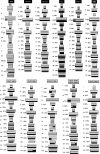Comparative genomics among Saccharomyces cerevisiae × Saccharomyces kudriavzevii natural hybrid strains isolated from wine and beer reveals different origins
- PMID: 22906207
- PMCID: PMC3468397
- DOI: 10.1186/1471-2164-13-407
Comparative genomics among Saccharomyces cerevisiae × Saccharomyces kudriavzevii natural hybrid strains isolated from wine and beer reveals different origins
Abstract
Background: Interspecific hybrids between S. cerevisiae × S. kudriavzevii have frequently been detected in wine and beer fermentations. Significant physiological differences among parental and hybrid strains under different stress conditions have been evidenced. In this study, we used comparative genome hybridization analysis to evaluate the genome composition of different S. cerevisiae × S. kudriavzevii natural hybrids isolated from wine and beer fermentations to infer their evolutionary origins and to figure out the potential role of common S. kudriavzevii gene fraction present in these hybrids.
Results: Comparative genomic hybridization (CGH) and ploidy analyses carried out in this study confirmed the presence of individual and differential chromosomal composition patterns for most S. cerevisiae × S. kudriavzevii hybrids from beer and wine. All hybrids share a common set of depleted S. cerevisiae genes, which also are depleted or absent in the wine strains studied so far, and the presence a common set of S. kudriavzevii genes, which may be associated with their capability to grow at low temperatures. Finally, a maximum parsimony analysis of chromosomal rearrangement events, occurred in the hybrid genomes, indicated the presence of two main groups of wine hybrids and different divergent lineages of brewing strains.
Conclusion: Our data suggest that wine and beer S. cerevisiae × S. kudriavzevii hybrids have been originated by different rare-mating events involving a diploid wine S. cerevisiae and a haploid or diploid European S. kudriavzevii strains. Hybrids maintain several S. kudriavzevii genes involved in cold adaptation as well as those related to S. kudriavzevii mitochondrial functions.
Figures


Similar articles
-
Molecular characterization of new natural hybrids of Saccharomyces cerevisiae and S. kudriavzevii in brewing.Appl Environ Microbiol. 2008 Apr;74(8):2314-20. doi: 10.1128/AEM.01867-07. Epub 2008 Feb 22. Appl Environ Microbiol. 2008. PMID: 18296532 Free PMC article.
-
Ecological success of a group of Saccharomyces cerevisiae/Saccharomyces kudriavzevii hybrids in the northern european wine-making environment.Appl Environ Microbiol. 2012 May;78(9):3256-65. doi: 10.1128/AEM.06752-11. Epub 2012 Feb 17. Appl Environ Microbiol. 2012. PMID: 22344648 Free PMC article.
-
A comparison of the performance of natural hybrids Saccharomyces cerevisiae × Saccharomyces kudriavzevii at low temperatures reveals the crucial role of their S. kudriavzevii genomic contribution.Int J Food Microbiol. 2018 Jun 2;274:12-19. doi: 10.1016/j.ijfoodmicro.2018.03.002. Epub 2018 Mar 7. Int J Food Microbiol. 2018. PMID: 29574243
-
On the origins and industrial applications of Saccharomyces cerevisiae × Saccharomyces kudriavzevii hybrids.Yeast. 2018 Jan;35(1):51-69. doi: 10.1002/yea.3283. Epub 2017 Dec 6. Yeast. 2018. PMID: 29027262 Review.
-
Interspecies hybridization and recombination in Saccharomyces wine yeasts.FEMS Yeast Res. 2008 Nov;8(7):996-1007. doi: 10.1111/j.1567-1364.2008.00369.x. Epub 2008 Mar 18. FEMS Yeast Res. 2008. PMID: 18355270 Review.
Cited by
-
Hybridization within Saccharomyces Genus Results in Homoeostasis and Phenotypic Novelty in Winemaking Conditions.PLoS One. 2015 May 6;10(5):e0123834. doi: 10.1371/journal.pone.0123834. eCollection 2015. PLoS One. 2015. PMID: 25946464 Free PMC article.
-
A Novel Approach to Isolating Improved Industrial Interspecific Wine Yeasts Using Chromosomal Mutations as Potential Markers for Increased Fitness.Front Microbiol. 2018 Jul 3;9:1442. doi: 10.3389/fmicb.2018.01442. eCollection 2018. Front Microbiol. 2018. PMID: 30034376 Free PMC article.
-
Reconstruction of the evolutionary history of Saccharomyces cerevisiae x S. kudriavzevii hybrids based on multilocus sequence analysis.PLoS One. 2012;7(9):e45527. doi: 10.1371/journal.pone.0045527. Epub 2012 Sep 25. PLoS One. 2012. PMID: 23049811 Free PMC article.
-
Genomics and the making of yeast biodiversity.Curr Opin Genet Dev. 2015 Dec;35:100-9. doi: 10.1016/j.gde.2015.10.008. Epub 2015 Nov 30. Curr Opin Genet Dev. 2015. PMID: 26649756 Free PMC article. Review.
-
Assessing genetic diversity among Brettanomyces yeasts by DNA fingerprinting and whole-genome sequencing.Appl Environ Microbiol. 2014 Jul;80(14):4398-413. doi: 10.1128/AEM.00601-14. Epub 2014 May 9. Appl Environ Microbiol. 2014. PMID: 24814796 Free PMC article.
References
-
- Lopandić K, Gangl H, Wallner E, Tscheik G, Leitner G, Querol A, Borth N, Breitenbach M, Prillinger H, Tiefenbrunner W. Genetically different wine yeasts isolated from Austrian vine-growing regions influence wine aroma differently and contain putative hybrids between Saccharomyces cerevisiae and Saccharomyces kudriavzevii. FEMS Yeast Res. 2007;7:953–965. doi: 10.1111/j.1567-1364.2007.00240.x. - DOI - PubMed
-
- de Barros Lopes M, Bellon JR, Shirley NJ, Ganter PF. Evidence for multiple interspecific hybridization in Saccharomyces sensu stricto species. FEMS Yeast Res. 2002;1:323–331. - PubMed
Publication types
MeSH terms
Substances
LinkOut - more resources
Full Text Sources
Other Literature Sources
Molecular Biology Databases

